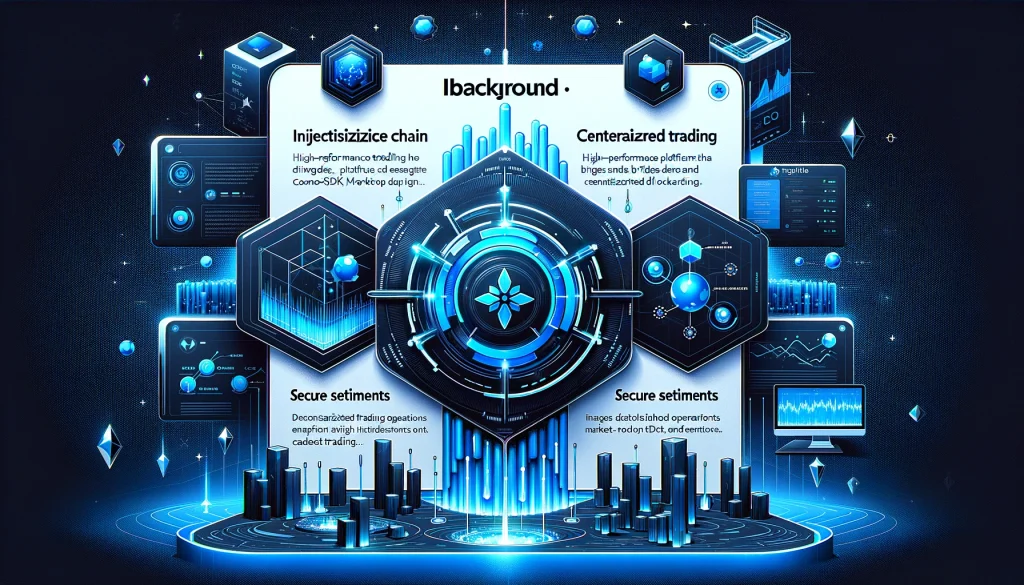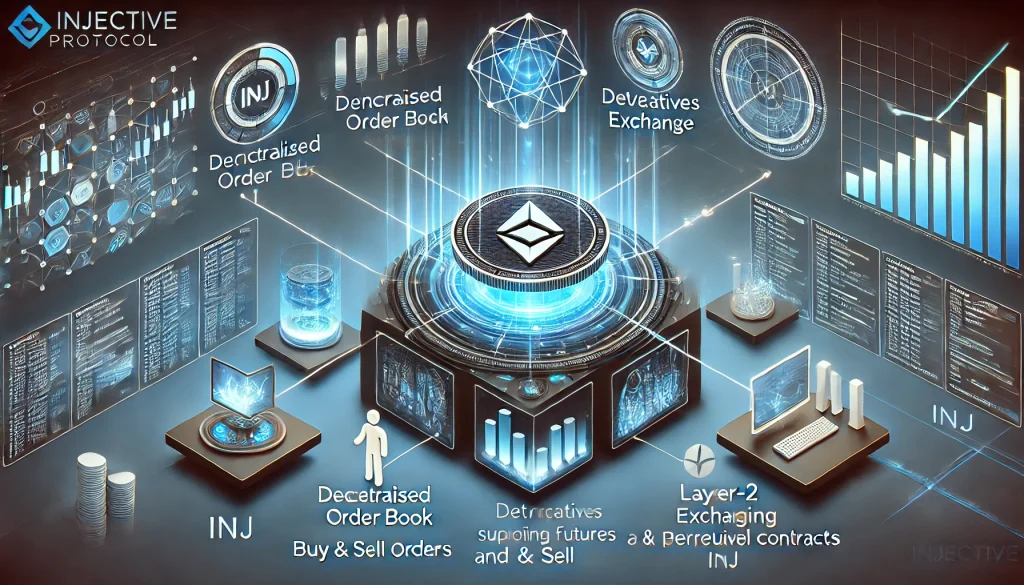
Blockchain technology has given rise to numerous decentralized systems that promise to transform industries by enhancing security, transparency, and efficiency. Among these innovations, this stands out as a powerful layer-2 decentralized exchange protocol that enables users to trade across a wide variety of assets. In a world where the demand for decentralized finance (DeFi) solutions is rapidly increasing, understanding the Injective Protocol and its associated components like the injective coin and injective talis is essential for anyone looking to explore the future of trading and blockchain technology.
What is Injective Protocol?
The Injective Protocol is a fully decentralized, layer-2 protocol designed for building powerful, secure, and efficient decentralized finance (DeFi) applications. It allows for seamless trading across different financial markets, eliminating the need for a central intermediary. Through its unique infrastructure, It enables users to create and trade on decentralized order books, providing an open and transparent marketplace for all kinds of assets. It also features a decentralized derivatives exchange, which allows for trading futures and perpetual contracts. This empowers users to trade without limitations, offering features that are typically only available on centralized exchanges, but with the added benefits of decentralization. Additionally, the injective coin plays a critical role in the protocol, serving as the primary token for transactions, staking, and governance.
Background of Injective Protocol

At its core, the Injective Protocol is a platform that bridges the gap between decentralized and centralized trading by providing a high-performance exchange system without the drawbacks of traditional exchanges. Central to this is the Injective Chain, a layer-2 Cosmos-SDK-based blockchain that is optimized for DeFi applications. This chain is responsible for executing and settling trades, and it is fully decentralized, ensuring that no single entity can control the market.
The protocol integrates multiple components, including a decentralized order book, a robust derivatives exchange, and a fast layer-2 exchange infrastructure. Each of these components works in tandem to ensure that users experience a smooth, secure, and efficient trading process. Moreover, the Injective Protocol is fully compatible with Ethereum, enabling it to leverage the vast ecosystem of Ethereum-based assets and applications. Through this compatibility, users can seamlessly transfer assets between Ethereum and Injective, making it a versatile tool for traders and developers alike. Notably, the injective coin facilitates transactions and staking within the network, while injective talis is an emerging aspect of the ecosystem, adding further depth to its offerings.
Origins/History
Eric Chen and Albert Chon conceived the Injective Protocol in 2018, recognizing the need for a truly decentralized exchange that could rival centralized exchanges in speed, efficiency, and user experience. The protocol gained significant attention after Binance Labs, one of the most prominent venture arms in the blockchain space, backed it.
| Year | Milestone |
|---|---|
| 2018 | Founding of Injective Protocol |
| 2020 | Binance Labs investment and mainnet launch |
| 2021 | Integration with Ethereum and launch of decentralized derivatives exchange |
Throughout its development, this has continued to evolve, incorporating cutting-edge technology and expanding its capabilities to meet the growing demands of the DeFi space. Today, it stands as a leading platform in the decentralized trading ecosystem, offering a range of tools and services that cater to both retail and institutional traders.
Types of Injective Protocol

The Injective Protocol can be broken down into several key components, each serving a distinct purpose within the ecosystem.
| Type | Description |
|---|---|
| Decentralized Exchange (DEX) | A fully decentralized platform for trading a variety of assets without the need for intermediaries. |
| Derivatives Exchange | Supports the trading of futures, perpetual contracts, and other derivative instruments. |
| Injective Chain | A layer-2 blockchain optimized for DeFi, enabling fast and secure transaction processing. |
| Order Book | A decentralized order book that matches buy and sell orders in real-time. |
| Staking Mechanism | Allows users to stake INJ tokens to secure the network and earn rewards. |
Each of these components plays a critical role in the overall functionality of the Injective Protocol, ensuring that users can trade with confidence and efficiency across a wide range of markets. The injective coin is integral to this process, enabling transactions and staking, while injective talis is a developing feature that promises to enhance the protocol’s capabilities further.
How does Injective Protocol work?
The Injective Protocol operates by utilizing a combination of blockchain technology and decentralized finance principles. It leverages the Injective Chain to execute trades, ensuring decentralized processing of all transactions. The order book is also decentralized, meaning orders are matched on a peer-to-peer basis without the need for a central authority.
One of the standout features of this is its layer-2 scaling solution, which allows for faster transaction processing and reduced fees compared to traditional layer-1 blockchains like Ethereum. This makes the protocol particularly appealing for high-frequency traders who require quick and efficient order execution. The injective coin is pivotal in this operation, serving as the fuel for transactions within the ecosystem.
Injective Protocol Pros & Cons
When evaluating, it’s essential to consider both its advantages and disadvantages to get a comprehensive understanding of its impact and potential in the decentralized finance (DeFi) space. The protocol offers numerous benefits, particularly in terms of decentralization, security, and transaction efficiency. However, like any technology, it also has its challenges, including complexity for new users and potential regulatory concerns. Below is a summary of the key pros and cons associated with the Injective Protocol:
| Pros | Cons |
|---|---|
| Fully decentralized, offering greater security and transparency. | Complexity may be challenging for beginners. |
| Low transaction fees due to layer-2 scaling. | Limited liquidity compared to centralized exchanges. |
| Supports a wide range of assets, including derivatives. | Regulatory uncertainties surrounding DeFi. |
| High-speed transactions and order execution. | Dependency on Ethereum for asset transfers. |
| Strong community support and developer ecosystem. | Potential for network congestion during high traffic. |
Companies with Injective Protocol
Several companies and projects have adopted the Injective Protocol as part of their blockchain infrastructure, leveraging its unique features to enhance their offerings.
Binance Labs
As an early backer of Injective Protocol, Binance Labs has played a significant role in its development and adoption. The investment from Binance Labs helped accelerate the protocol’s growth, bringing it to the attention of a broader audience within the blockchain space.
Pantera Capital
Pantera Capital is another major player in the blockchain investment space that has supported the Injective Protocol. Their involvement has provided additional resources and credibility, helping to establish Injective as a leading decentralized exchange protocol.
Stafi Protocol
Stafi Protocol, a decentralized finance platform focused on staking derivatives, has integrated Injective’s technology to offer more efficient and secure staking solutions. This partnership highlights the versatility and utility of the Injective Protocol across different DeFi applications.
Applications of Injective Protocol
The Injective Protocol has a wide range of applications, particularly within the decentralized finance sector. Its flexibility and advanced features make it suitable for various use cases.
Decentralized Trading Platforms
The most common application of the Injective Protocol is in the creation of decentralized trading platforms. These platforms allow users to trade a variety of assets without the need for a central authority, providing greater security and control over their funds.
Derivatives Markets
Injective Protocol’s support for derivatives trading is another major application. By enabling decentralized trading of futures and perpetual contracts, the protocol opens up new opportunities for traders to hedge risks and speculate on price movements in a secure environment.
Cross-Chain Trading
One of the unique features of this is its ability to facilitate cross-chain trading. This allows users to trade assets across different blockchains seamlessly, providing access to a wider range of markets and liquidity.
Staking Platforms
Injective Protocol’s staking mechanism is also used in various DeFi platforms to secure networks and earn rewards. Users can stake their injective coin tokens to participate in the network’s governance and consensus process.
DeFi Applications
Beyond trading and staking, the Injective Protocol is also integrated into various decentralized finance applications. These applications leverage Injective’s infrastructure to offer innovative financial products and services, such as lending, borrowing, and yield farming. The introduction of injective talis could further diversify these applications, providing new tools and opportunities within the ecosystem.
Conclusion
Understanding the Injective Protocol is crucial for anyone involved in the blockchain or DeFi space. As a powerful and versatile decentralized exchange protocol, it offers numerous advantages over traditional centralized exchanges, including enhanced security, lower fees, and greater transparency. By providing a platform for decentralized trading, derivatives markets, and cross-chain transactions, this is poised to play a significant role in the future of finance. The injective coin and emerging features like injective talis add further depth and utility to this groundbreaking protocol.
References
- Coinmerce. What is Injective Protocol (INJ)?
- Kraken. What is Injective (INJ)?
- LeewayHertz. Everything about Injective Protocol.
- Bitstamp. What is Injective (INJ)?
- Blox. Injective Protocol (INJ) Overview.
